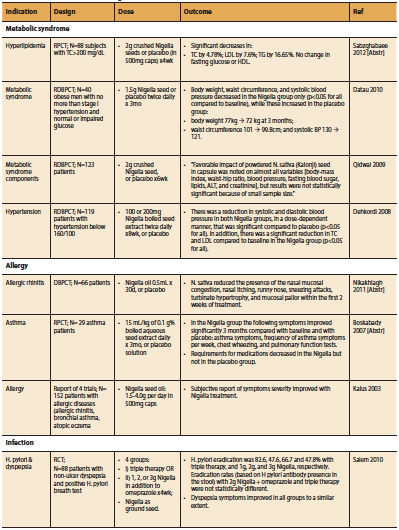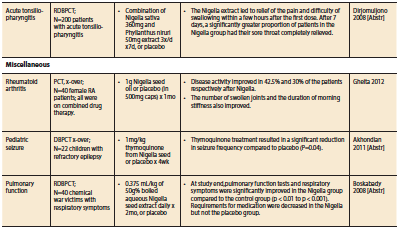Nigella Sativa
A Panacea for Human Disease
Abstract
Nigella sativa, also known as black cumin, is a highly-regarded and prominent herb that has been used in traditional Middle Eastern and Indian systems of medicine. The Prophet Muhammad was recorded as stating that the herb can cure any disease, other than death. Many therapeutic activities have been ascribed to Nigella, including astringent, bitter, stimulant, anthelminthic, carminative, anodyne, expectorant and other effects. In modern research, Nigella has been shown to possess potent anti-inflammatory activity, lipid, glucose, and blood pressure lowering effects, anti-allergic effects, as well as neuroprotective, antimicrobial, and smooth muscle relaxing effects. Preclinical research has indicated potentially important anticancer effects, though this has yet to be investigated in human studies. These effects have been attributed in large part to the constituent thymoquinone. This long list of therapeutic effects demonstrated by scientific research reinforces the traditional view of this impressive herb.
Introduction
Nigella sativa, also known as black cumin, is part of the Ranunculaceae family and an herb with a long history of traditional use in southeast Asia, Egypt, Greece, and the Middle East (Khan 2011). Nigella was regarded as a panacea by the ancients, and played a central role in the medical practice of Middle Eastern and South Asian societies for over 2000 years, where it was used for the treatment of a range of conditions including asthma, headache, dysentery, infection, back pain, dermatological and gastrointestinal conditions (Isik 2010). In traditional Indian medicine, Nigella seeds are astringent, bitter, stimulant, diuretic, emmenagogue, anthelmintic, galactogogue, carminative, anodyne, sudorific, febrifuge, expectorant, purgative, and abortifacient (Parrakh 2010). The medieval Islamic philosopher Avicenna wrote of Nigella in his Canon of Medicine, that it stimulates the body’s energy and helps recovery from fatigue and dispiritedness (Parrakh 2010). Mohammed is reported to have said that the seed has the power to cure every disease except death (Parrakh 2010).
Medicinally, Nigella has been used in the form of crushed seed, oil, and water extract. The activity of Nigella has been attributed in to its thymoquinone content, which is present in both the fixed and essential oils of Nigella; thymoquinone has been extracted and used therapeutically in isolation (Akhondian 2011, Paarakh 2010).
Nigella oil also contains plant sterols, as well as 25% oleic acid/ 55% linoleic acid, nigellone, and volatile oils including thymol, limonene, and carvacrol (Isik 2010, Paarakh 2010). It is also possible that fibre content may mediate part of the metabolic effects of Nigella.
Mechanism of Action: Preclinical Evidence
There is a wealth of information on Nigella and thymoquinione derived from preclinical research. Thymoquinone appears to be capable of protecting tissues and organs from various types of damage due to antiinflammatory and antioxidant activity, and has also been investigated for its anticancer effects (Woo 2012). In animal models of diabetes, thymoquinone was shown to inhibit cellular expression of the COX-2 enzyme and increased levels of the antioxidant enzyme superoxide dismutase (Al Wafai 2013). In models of hyperlipidemia, Nigella sativa volatile oil and methanol extract have both been shown to reduce triglyceride and increase HDL, as well as decrease hepatic HMG-CoA reductase activity (Ahmad 2013). In smooth muscle tissue, including intestinal and bronchial tissue, thymoquinone has been shown to inhibit spontaneous contraction via inhibition of voltage-gated calcium channels (Ghayur 2012). Thymoquinone has also been shown to inhibit liver fibrosis (Bai 2013); attenuate lung injury and fibrosis (El-Khouly 2012); attenuate diabetic nephropathy (Sayed 2012); prevent E. coli induced tissue damage in bacterial prostatitis (Inci 2013); and prevent dextran sulfate sodium-induced colitis (Lei 2012).
In an animal model of epilepsy, thymoquinone was shown to have antioxidant effects in attenuating malondialdehyde (a marker of lipid peroxidation), reduced neurodegenerative changes and neuron loss, and decreased the number of reactive astrocytes (astrogliosis) (Dariani 2013). Thymoquinone has also been shown to have protective effects against amyloid β-induced neurotoxicity, leading to the suggestion that Nigella may have therapeutic potential in Alzheimer’s disease (Alhebshi 2013).
Nigella and its constituent thymoquinone have also been extensively studied in lab models for its anticancer effects. Thymoquinone has been shown to have pro-apoptotic effects in breast cancer, including synergistically with tamoxifen (Rajput 2013); and has been shown to inhibit cancer cell growth and invasiveness in lung, liver, colon, melanoma, and breast cancer cells (Attoub 2012). This is an area where further research is needed to investigate these promising activities.
Clinical Trials
There is a well-developed body of evidence investigating Nigella in humans. Nigella has been shown to have anti-diabetic, blood pressure and cholesterol lowering effects. It also has activity against specific types of infection, possesses anti-allergic effects, and improves rheumatoid arthritis as well as pediatric seizures. Table 1 summarizes all available evidence from human intervention trials concerning the herb as identified through Pubmed and Google Scholar.
In metabolic syndrome, Nigella seed has been shown to significantly decrease total cholesterol, LDL, and triglyceride (Dehkordi 2008, Sabzghabaee 2012), improve fasting and post-prandial glucose and HbA1C (Bamosa 2010), decrease systolic blood pressure (Datau 2010, Dehkordi 2008) by almost 10 points in one study (Datau 2010), as well as promote reduction of body weight and waist circumference (Datau 2010). In the area of allergy and asthma, Nigella oil or extract has been shown to significantly reduce symptoms of allergic rhinitis (Kalus 2003,Nikakhlagh 2011), as well as reduce the severity and frequency of asthma symptoms, improve lung function tests, and reduce the need for asthma medications (Boskabady 2007). Also related to respiratory function are two studies showing that Nigella can act as an antimicrobial agent in acute pharyngitis (Dirjomuljono 2008), and improve lung function, respiratory symptoms, as well as medication requirements in patients who were victims of chemical warfare (Boskabady 2008). One study found that Nigella seed in combination with omeprazole was equal to triple therapy in the eradication of H. pylori (Salem 2010). Finally, one study each showed that Nigella was effective in reducing disease activity of rheumatoid arthritis (Gheita 2012), and reduce the frequency of seizures in patients with refractory epilepsy (Akhondian 2011).
Dosage
The effective dosage forms and quantities of Nigella used include 2g of ground seeds in metabolic syndrome or syndrome components (Sabzghabaee 2012); 1-4g seed oil for inflammatory conditions such as allergy and arthritis (Gheita 2012, Kalus 2003); 1mg/kg thymoquinone in pediatric seizure (Akhondian 2011); and varying doses of a boiled aqueous extract (Boskabady 2007, Boskabady 2008).


Safety
Based on the studies in Table 1 as well as the impressive range of activities demonstrated in preclinical research, Nigella appears to possess powerful disease modifying potential in a range of conditions. The only adverse events reported with any consistency among the trials were mild gastrointestinal upset (Akhondion 2011, Bamosa 2010, Salem 2010). Overall, Nigella and/ or thymoquinone appears to have a good safety profile (Al-Ali 2008). In animals, toxicity was demonstrated only at dosages of 250 mg/kg thymoquinone by oral route (maximum tolerated dose) (Abukhader 2012). When given by intraperitoneal injection, toxicity occurred at a dose of between 15-20mg/kg thymoquinone, more than 10-fold the dose used in human trials (Abukhader 2012). Signs of toxicity were acute pancreatitis and peritonitis (Abukhader 2012). In another study, the LD50 of thymoquinone by oral administration was 870.9 mg/kg, more than 100 to 150-fold higher than the therapeutic dose (Al-Ali 2008).
Conclusion
Nigella sativa is a highly regarded herb with a long tradition of use for infection, conditions of inflammation, respiratory and gastrointestinal conditions, and more. Human trials have demonstrated benefits from Nigella seed in metabolic conditions such as dyslipidemia, type 2 diabetes, and hypertension; and Nigella oil or extract in allergy and asthma, inflammatory conditions, infections including pharyngitis and H. pylori, as well as refractory epilepsy. Further research is needed to elucidate the potential anticancer effects of Nigella suggested by preclinical findings.
References
Abukhader MM. The effect of route of administration in thymoquinone toxicity in male and female rats. Indian J Pharm Sci. 2012 May;74(3):195-200.
Ahmad S, Beg ZH. Elucidation of mechanisms of actions of thymoquinone-enriched methanolic and volatile oil extracts from Nigella sativa against cardiovascular risk parameters in experimental hyperlipidemia. Lipids Health Dis. 2013 Jun 13;12(1):86. [Epub ahead of print]
Akhondian J, Kianifar H, Raoofziaee M, Moayedpour A, Toosi MB, Khajedaluee M. The effect of thymoquinone on intractable pediatric seizures (pilot study). Epilepsy Res. 2011 Jan;93(1):39-43.
Al-Ali A, Alkhawajah AA, Randhawa MA, Shaikh NA. Oral and intraperitoneal LD50 of thymoquinone, an active principle of Nigella sativa, in mice and rats. J Ayub Med Coll Abbottabad. 2008 Apr-Jun;20(2):25-7.
Alhebshi AH, Gotoh M, Suzuki I. Thymoquinone protects cultured rat primary neurons against amyloid β-induced neurotoxicity. Biochem Biophys Res Commun. 2013 Apr 19;433(4):362-7.
Al Wafai RJ. Nigella sativa and thymoquinone suppress cyclooxygenase-2 and oxidative stress in pancreatic tissue of streptozotocin-induced diabetic rats. Pancreas. 2013 Jul;42(5):841-9.
Attoub S, Sperandio O, Raza H, Arafat K, Al-Salam S, Al Sultan MA, Al Safi M, Takahashi T, Adem A. Thymoquinone as an anticancer agent: evidence from inhibition of cancer cells viability and invasion in vitro and tumor growth in vivo. Fundam Clin Pharmacol. 2012 Jun 11.
Bai T, Lian LH, Wu YL, Wan Y, Nan JX. Thymoquinone attenuates liver fibrosis via PI3K and TLR4 signaling pathways in activated hepatic stellate cells. Int Immunopharmacol. 2013 Feb;15(2):275-81.
Bamosa AO, Kaatabi H, Lebdaa FM, Elq AM, Al-Sultanb A. Effect of Nigella sativa seeds on the glycemic control of patients with type 2 diabetes mellitus. Indian J Physiol Pharmacol. 2010 Oct-Dec;54(4):344-54.
Boskabady MH, Farhadi J. The possible prophylactic effect of Nigella sativa seed aqueous extract on respiratory symptoms and pulmonary function tests on chemical war victims: a randomized, double-blind, placebo-controlled trial. J Altern Complement Med. 2008 Nov;14(9):1137-44.
Boskabady MH, Javan H, Sajady M, Rakhshandeh H. The possible prophylactic effect of Nigella sativa seed extract in asthmatic patients. Fundam ClinP harmacol. 2007 Oct;21(5):559-66. Erratum in: Fundam Clin Pharmacol. 2008 Feb;22(1):105.
Dariani S, Baluchnejadmojarad T, Roghani M. Thymoquinone Attenuates Astrogliosis, Neurodegeneration, Mossy Fiber Sprouting, and Oxidative Stress in a Model of Temporal Lobe Epilepsy. J Mol Neurosci. 2013 Jun 23. [Epub ahead of print]
Datau EA, Wardhana, Surachmanto EE, Pandelaki K, Langi JA, Fias. Efficacy of Nigella sativa on serum free testosterone and metabolic disturbances in central obese male. Acta Med Indones. 2010 Jul;42(3):130-4.
Dehkordi FR, Kamkhah AF. Antihypertensive effect of Nigella sativa seed extract in patients with mild hypertension. Fundam Clin Pharmacol. 2008 Aug;22(4):447-52.
Dirjomuljono M, Kristyono I, Tjandrawinata RR, Nofiarny D. Symptomatic treatment of acute tonsillopharyngitis patients with a combination of Nigella sativa and Phyllanthus niruri extract. Int J Clin Pharmacol Ther. 2008 Jun;46(6):295-306.
El-Khouly D, El-Bakly WM, Awad AS, El-Mesallamy HO, El-Demerdash E. Thymoquinone blocks lung injury and fibrosis by attenuating bleomycin-induced oxidative stress and activation of nuclear factor Kappa-B in rats. Toxicology. 2012 Dec 16;302(2-3):106-13.
Ghayur MN, Gilani AH, Janssen LJ. Intestinal, airway, and cardiovascular relaxant activities of thymoquinone. Evid Based Complement Alternat Med. 2012;2012:305319.
Gheita TA, Kenawy SA. Effectiveness of Nigella sativa oil in the management of rheumatoid arthritis patients: a placebo controlled study. Phytother Res. 2012 Aug;26(8):1246-8.
Inci M, Davarci M, Inci M, Motor S, Yalcinkaya FR, Nacar E, Aydin M, Sefil NK, Zararsiz I. Anti-inflammatory and antioxidant activity of thymoquinone in a rat model of acute bacterial prostatitis. Hum Exp Toxicol. 2013 Apr;32(4):354-61.
Işik H, Cevikbaş A, Gürer US, Kiran B, Uresin Y, Rayaman P, Rayaman E, Gürbüz B, Büyüköztürk S. Potential adjuvant effects of Nigella sativa seeds to improve specific immunotherapy in allergic rhinitis patients. Med Princ Pract. 2010;19(3):206-11.
Kalus U, Pruss A, Bystron J, Jurecka M, Smekalova A, Lichius JJ, Kiesewetter H. Effect of Nigella sativa (black seed) on subjective feeling in patients with allergic diseases. Phytother Res. 2003 Dec;17(10):1209-14.
Khan MA, Chen HC, Tania M, Zhang DZ. Anticancer activities of Nigella sativa (black cumin). Afr J Tradit Complement Altern Med. 2011;8(5 Suppl):226-32.
Lei X, Liu M, Yang Z, Ji M, Guo X, Dong W. Thymoquinone prevents and ameliorates dextran sulfate sodium-induced colitis in mice. Dig Dis Sci. 2012 Sep;57(9):2296-303.
Nikakhlagh S, Rahim F, Aryani FH, Syahpoush A, Brougerdnya MG, Saki N. Herbal treatment of allergic rhinitis: the use of Nigella sativa. Am J Otolaryngol. 2011 Sep-Oct;32(5):402-7.
Paarakh PM. Nigella sativa Linn. – a comprehensive review. Indian Journal of Natural Products and Resources. 2010 Dec;1(4):409-29.
Qidwai W, Hamza HB, Qureshi R, Gilani A. Effectiveness, safety, and tolerability of powdered Nigella sativa (kalonji) seed in capsules on serum lipid levels, blood sugar, blood pressure, and body weight in adults: results of a randomized, doubleblind controlled trial. J Altern Complement Med. 2009 Jun;15(6):639-44.
Rajput S, Kumar BN, Sarkar S, Das S, Azab B, Santhekadur PK, Das SK, Emdad L, Sarkar D, Fisher PB, Mandal M. Targeted apoptotic effects of thymoquinone and tamoxifen on XIAP mediated Akt regulation in breast cancer. PLoS One. 2013 Apr 17;8(4):e61342.
Sabzghabaee AM, Dianatkhah M, Sarrafzadegan N, Asgary S, Ghannadi A. Clinical evaluation of Nigella sativa seeds for the treatment of hyperlipidemia: a randomized, placebo controlled clinical trial. Med Arh. 2012;66(3):198-200.
Salem EM, Yar T, Bamosa AO, Al-Quorain A, Yasawy MI, Alsulaiman RM, Randhawa MA. Comparative study of Nigella Sativa and triple therapy in eradication of Helicobacter Pylori in patients with non-ulcer dyspepsia. Saudi J Gastroenterol. 2010 Jul-Sep;16(3):207-14.
Sayed AA. Thymoquinone and proanthocyanidin attenuation of diabetic nephropathy in rats. Eur Rev Med Pharmacol Sci. 2012 Jun;16(6):808-15.
Woo CC, Kumar AP, Sethi G, Tan KH. Thymoquinone: potential cure for inflammatory disorders and cancer. Biochem Pharmacol. 2012 Feb 15;83(4):443-51.









